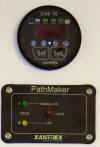
Free power, free jump...
The Pathmaker is another Xantrex product. It is a smart switch which connects the service, or grooming, batteries to the vehicle's battery/charging system. The primary purpose is to allow the vehicle's alternator to charge the service batteries when the vehicle has excess voltage available. A secondary feature is the ability to connect the two systems, manually, to use the service batteries to act as a "jump start" for the vehicle.
For convenience, there is a remote switch panel mounted in the attic control panel. This connects via RJ-14 modular connector to the main device, located in the rear compartment near the service batteries. The remote control panel connection is extended, with discreet conductors, through the roof-top conduits and terminated on RJ-14 jacks connected by short patch cords.
The two battery systems are interconnected with 0000 AWG conductors running from the vehicle battery to the service batteries in the rear compartment.
The diagram below shows the generic wiring of the device. The switch in the diagram, above the Pathmaker label is an optional part of the system, and not present in our installation. The complete wiring of the device consists of connecting the VB1 and VB2 terminals to the service and vehicle batteries respectively. All the vehicle loads connect to the vehicle battery, labeled START. All the grooming loads connect to the service batteries, labeled HOUSE.
The drawing above does not show the remote control unit or any fuses.
The Pathmaker has a remote control on the attic control panel, the rectangular device in the photo below.
The Pathmaker device has a six position RJ-11 jack, as does the remote control unit. The remote is supplied with a 25', six conductor, telephone type flat cable. Unfortunately, Xantrex support could not confirm how many conductors are actually used, so all six were extended between two jacks in the rear and attic.
Besides the two heavy cable connections to the power terminals, the only other connection is a ground on the left-most terminal of the strip on the unit.

